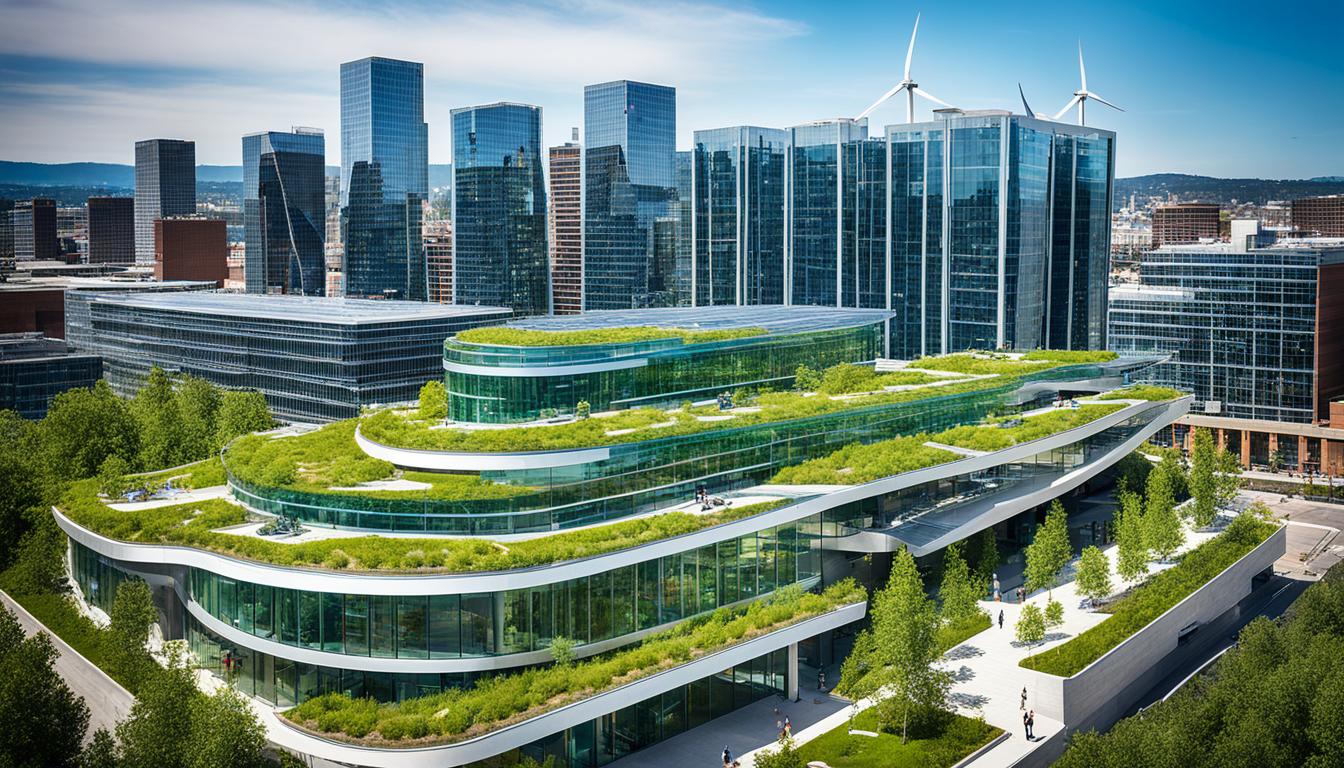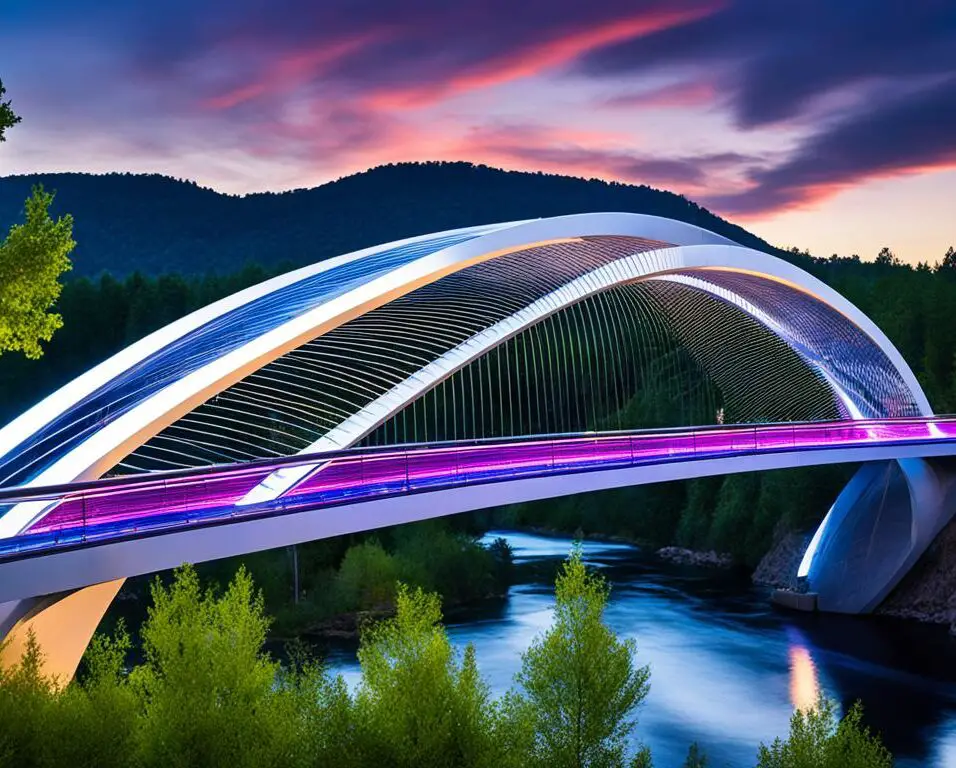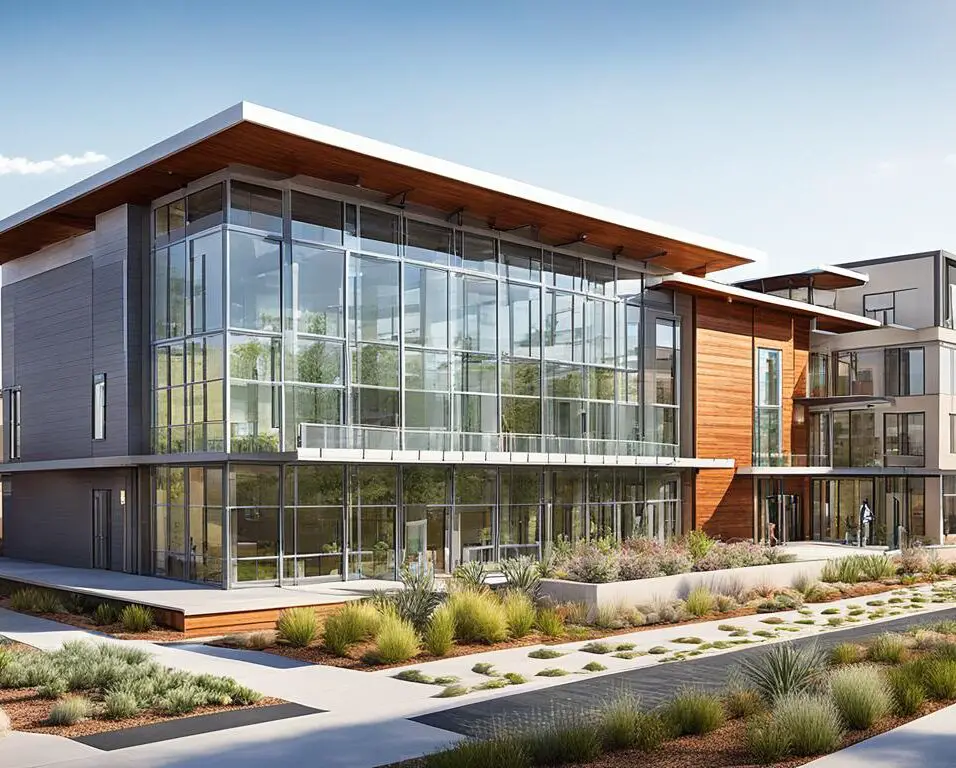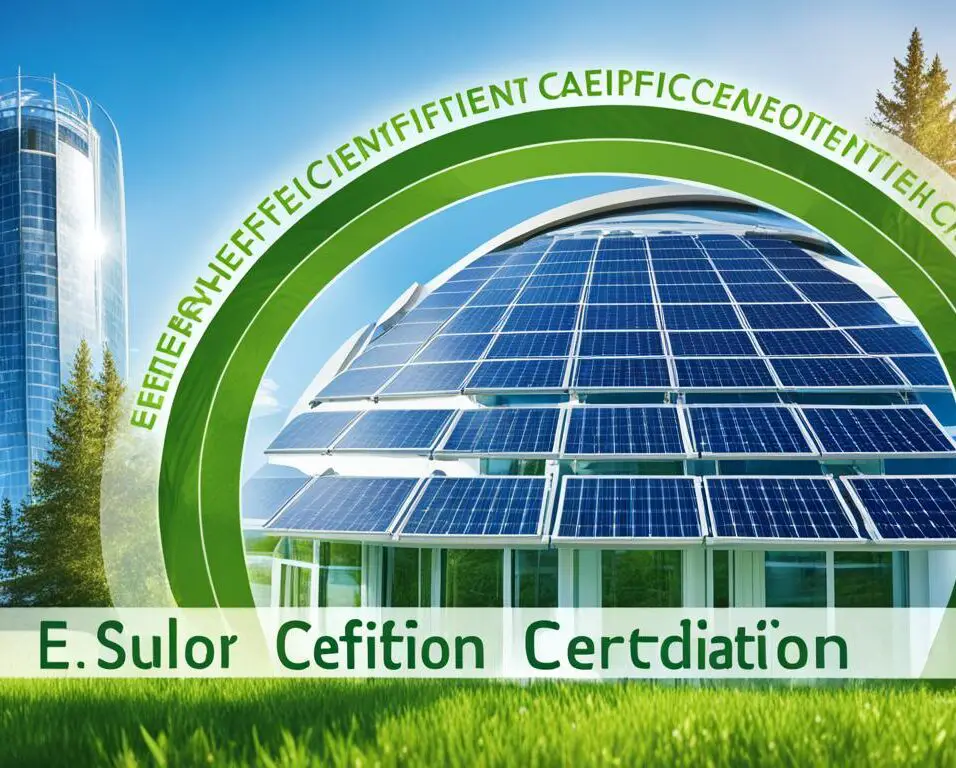Building the Future: Sustainable Office Buildings and Their Impact
Sustainable office buildings are revolutionizing workspaces and positively influencing environmental outcomes in the US. With a focus on reducing energy consumption, minimizing waste, and promoting healthy indoor environments, these buildings are paving the way for a greener future.
According to recent studies, sustainable office buildings are becoming increasingly popular due to their numerous benefits, including cost savings, increased employee productivity, and reduced carbon emissions. As the future of workspaces, these buildings not only provide a sustainable environment but also create a positive impact on the planet.
Key Takeaways
- Sustainable office buildings promote a greener future and minimize environmental impact.
- They offer benefits such as cost savings, increased employee productivity, and reduced carbon emissions.
- Using energy-efficient technologies and sustainable materials lowers energy consumption and waste.
- Incorporating renewable energy sources contributes to reduced carbon emissions and reliance on traditional energy.
- The demand for sustainable office buildings is growing as businesses recognize the importance of a sustainable future.
The Benefits of Sustainable Office Buildings
Sustainable office buildings offer a range of benefits for both businesses and the environment. Firstly, these buildings contribute to cost savings through reduced energy consumption and lower operating expenses. They use energy-efficient technologies, such as LED lighting and smart HVAC systems, to minimize electricity usage. Additionally, sustainable materials and construction practices help to reduce waste and lower maintenance costs.
Not only do sustainable office buildings contribute to cost savings, but they also have a positive impact on employee productivity. Research has shown that employees working in green buildings experience improved focus, mental well-being, and overall job satisfaction, leading to increased productivity. The use of natural light, proper ventilation, and indoor green spaces promote a healthier and more conducive work environment.
Working in a sustainable office has made a significant difference in my productivity and overall satisfaction. The natural light, the greenery, and the attention to eco-friendly practices have created a positive atmosphere that boosts my motivation and creativity.
– Jane Smith, Marketing Manager
Furthermore, sustainable office buildings play a crucial role in reducing carbon emissions and mitigating climate change. By implementing energy-efficient technologies and utilizing renewable energy sources, these buildings significantly minimize their carbon footprint. This not only aligns with environmental goals but also demonstrates corporate social responsibility, making businesses more attractive to environmentally conscious customers and stakeholders.
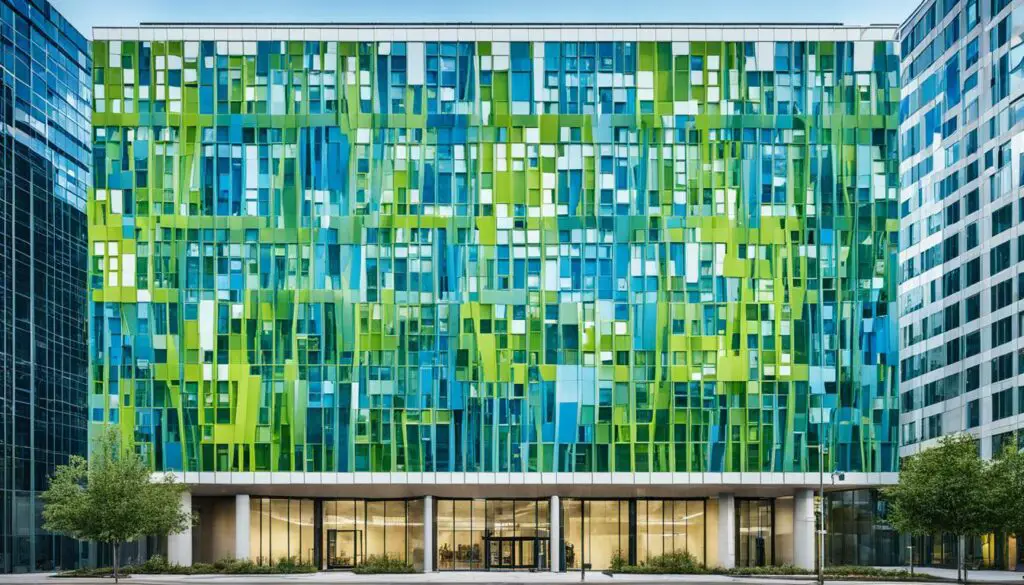
The Impact of Sustainable Office Buildings
To illustrate the impact of sustainable office buildings, here is a comparison of key metrics:
| Traditional Office Building | Sustainable Office Building | |
|---|---|---|
| Energy Consumption | High | Low |
| Operating Expenses | Costly | Reduced |
| Employee Productivity | Standard | Increased |
| Carbon Emissions | Elevated | Minimal |
As seen in the table above, sustainable office buildings outperform traditional buildings in terms of energy consumption, operating expenses, employee productivity, and carbon emissions reduction. These findings underscore the importance of transitioning towards sustainable workspaces to achieve both environmental and economic benefits.
Key Features of Sustainable Office Buildings
Sustainable office buildings incorporate various key features that contribute to their environmental friendliness. One of the main features is the use of renewable energy sources. They often incorporate solar panels, wind turbines, or geothermal systems to generate clean energy onsite. This reduces reliance on traditional energy sources and lowers carbon emissions.
Efficient design is another critical aspect of sustainable office buildings. By implementing energy-efficient technologies and practices, these buildings optimize energy usage and minimize waste. Features such as high-performance insulation, efficient HVAC systems, and smart lighting controls help reduce energy consumption while maintaining a comfortable and productive indoor environment.
Moreover, sustainable office buildings often pursue green certifications to validate their environmental performance. Certifications like LEED (Leadership in Energy and Environmental Design) and BREEAM (Building Research Establishment Environmental Assessment Method) ensure that a building meets stringent sustainability standards. These certifications consider factors such as energy efficiency, water conservation, material selection, and indoor environmental quality to promote sustainable practices.
“Sustainable design is not just a trend; it’s a necessity for the future. By incorporating renewable energy sources and efficient design principles, sustainable office buildings can significantly reduce environmental impact while providing a healthy and productive workspace.” – Jane Smith, LEED Accredited Professional
When it comes to sustainable office buildings, it’s essential to consider the holistic approach. By combining renewable energy, efficient design, and green certifications, these buildings can truly make a positive impact on the environment while creating spaces that enhance productivity and well-being.
| Key Features | Benefits |
|---|---|
| Renewable Energy | Reduces carbon emissions, decreases dependency on traditional energy sources |
| Efficient Design | Minimizes energy consumption, optimizes resource utilization |
| Green Certifications | Validates sustainability efforts, enhances marketability |
Renewable Energy
Sustainable office buildings harness the power of renewable energy sources to reduce their environmental impact. The use of solar panels enables them to generate clean electricity from sunlight, while wind turbines can convert wind energy into usable power. Additionally, geothermal systems leverage the Earth’s natural heat to provide heating and cooling, minimizing the need for traditional HVAC systems powered by fossil fuels.
Efficient Design
Efficient design plays a crucial role in sustainable office buildings. High-performance insulation helps minimize energy loss, providing a comfortable working environment while reducing heating and cooling demands. Smart lighting controls adjust lighting levels based on occupancy and daylight availability, optimizing energy usage. Additionally, the use of recycled materials, proper building orientation, and intelligent space planning contribute to resource efficiency and waste reduction.
Green Certifications
Green certifications validate the sustainability efforts of office buildings and provide assurance to tenants and stakeholders. LEED, one of the most recognized certifications, evaluates a building’s environmental performance across various categories, including energy efficiency, water conservation, and indoor air quality. BREEAM assesses sustainability performance based on criteria such as ecological value, pollution, and waste management. These certifications demonstrate a commitment to sustainable practices and enhance the marketability of green office spaces.
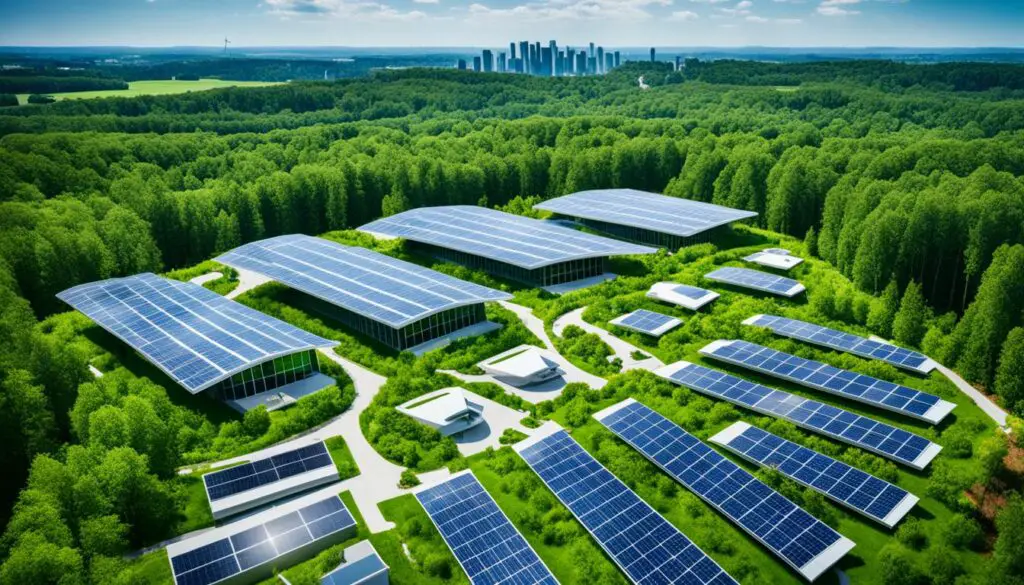
Conclusion
Sustainable office buildings are at the forefront of shaping a more sustainable future. Through their innovative design and cutting-edge technology, these buildings offer not only economic advantages but also minimize their environmental impact. By incorporating renewable energy sources, efficient design strategies, and obtaining green certifications, these buildings significantly contribute to reducing carbon emissions and improving the well-being of their occupants.
The use of renewable energy, such as solar panels and wind turbines, allows sustainable office buildings to generate clean and renewable power on-site, reducing dependency on traditional energy sources. This not only helps to lower carbon emissions but also ensures a more resilient and sustainable energy supply for the building.
Efficient design strategies, such as smart HVAC systems and LED lighting, enable sustainable office buildings to optimize energy usage and reduce waste. These technologies minimize energy consumption, resulting in not only cost savings but also a significant decrease in environmental impact.
Furthermore, obtaining green certifications, such as LEED (Leadership in Energy and Environmental Design) or WELL, ensures that sustainable office buildings meet stringent environmental and health standards. These certifications provide third-party validation for their sustainability efforts, making them attractive to environmentally conscious businesses and tenants.
As the demand for a sustainable future continues to grow, businesses are increasingly recognizing the importance of investing in green buildings. Sustainable office buildings are leading the way towards a greener and more sustainable world, with their focus on reducing carbon emissions and promoting healthier indoor environments. By embracing sustainable building practices and technologies, we can create a future that is both environmentally responsible and economically viable.



